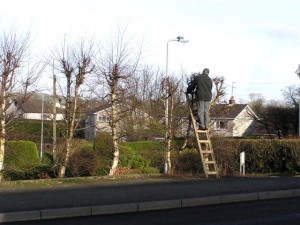 Lopping off tree limbs may sound like it would damage trees, but done correctly, it can help them grow and reduce the chance of property damage and injury. This guide will help you use your Cub Cadet pole saw effectively to keep your trees trimmed and healthy.
Lopping off tree limbs may sound like it would damage trees, but done correctly, it can help them grow and reduce the chance of property damage and injury. This guide will help you use your Cub Cadet pole saw effectively to keep your trees trimmed and healthy.
Why Prune?
There are three reasons to prune: to remove damaged and diseased branches in order to keep the tree healthy, to control the shape of the tree, and to remove unproductive growth to help keep the available nutrients going to the productive parts of the tree.
When Should I Prune?
Ideally, pruning should be done at the end of winter or the beginning of spring when there isn’t any fruit or leaves in the way and the tree will more readily seal off cuts as it comes out of dormancy. Additional pruning may be needed during the summer to remove damaged or diseased branches.
Pruning Small Trees
The primary reason to trim a young tree is to help form its shape. Branches tilting upward should be kept, while anything else should be cut off.
Often, when growing a new tree, smaller saplings called “suckers” will appear near the trunk, sprouting from other points of the tree’s root system. These should be removed, as they draw in nutrients from the soil that could be going to the tree’s crown, slowing growth.
Pruning Large Trees
Once the tree has matured, the next step is controlling growth to maintain the shape and health of the tree. This mostly involves thinning, cutting out branches that are bending back toward the trunk or are making the tree cover too cluttered. Done right, thinning can let more light through to aid plant growth below the tree’s canopy and reduce wind resistance, helping the tree withstand severe storms. There’s also canopy lifting, in which lower branches are trimmed back to maintain some space to walk or drive under the canopy.
Topping reshapes the top of the tree to keep it from damaging property, whether it may fall on your house or hit a power line. Doing this safely while also preventing shoots from growing out of the cut and changing the tree shape takes considerable skill and should be left to an arborist.
Deadwooding is the removal of dead tree limbs. Left alone, a dead limb will eventually drop off, leaving the rest of the tree unharmed. However, it’s a good idea to remove these limbs ahead of time so there’s no chance of the limb dropping on property or people underneath the tree.
Getting a Good Cut
There’s more to pruning than just lopping off some branches. Get the cut too wide, and the tree won’t seal off the exposed wood fast enough to prevent infections. Cut it unevenly, and the bark may create shoots that will add new branches, often going in undesirable angles. The goal with each cut is to leave the smallest, roundest surface possible.
When making a cut, it should be at a 90 degree angle from the side of the branch. Some branches will have a thick area covered in wrinkled bark called a “collar.” The cut should be made just past the end of this collar. Likewise, some high-angled branches will have thick, wrinkled bark between the branch and the tree. The cut should be made just above this area.
Putting Your Cub Cadet Pole Saw to Work
If you’re reading this article, chances are you own or plan on purchasing a Cub Cadet pole saw like their PS26 model. If you don’t have one yet, it’s definitely worth considering since it gives you a lot more cutting flexibility than you have working with a manual pole saw or a saw and ladder.
Stability is a must when operating a pole saw. If you can’t get good footing, place a sheet of plywood over the area you need to stand. Naturally, you’ll want to make sure any falling branches won’t strike anyone below them, including yourself.
To make the cut, place the bar on top of the branch you want to remove. Once you’re satisfied with the angle it’s at, start cutting. As you cut, pull the bar toward you, then lift up and set the back of the bar on the branch, repeating the process until the limb is cut off.
Keeping Your Pole Saw Ready to Use
A maintained pole saw is a safe pole saw. When you need spark plugs, chains, or even major components, visit www.cubparts.com. We’re a certified Cub Cadet dealer, carrying OEM replacements for everything on your PS 26, and we can ship these parts anywhere in the U.S. and Canada.
